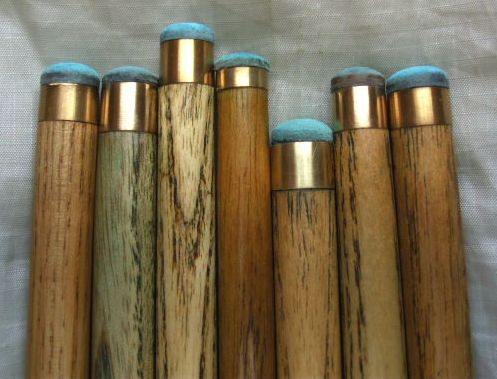Hi All,
before i continue, i would to add that the following results are purely based on my trial and error/exercises. so inevitably it will be my opinion lol.
i recently acquired 3 cues(almost identical in specs) butt size, taper, tip, size, weight, balance and even wood type and design.
i put 3 different ferrules on each cue - brass, stainless steel, black composite (similar to the MW blackspin)
i received three different results and they go as follows:
i will use my examples in the break off shot. white one inch away from brown, between yellow and brown playing 2 o clock (top right hand side) aiming for last red of the pack.
with the brass ferrule, i hit the third ball from the pack. with the SS i hot the second ball from the pack and the black ferrule i hit the last ball, which i intended to hit from the start.
with this i realised that the heavier the ferrule, the more the white will push in the opposite side of the side spin played.
now this is fine if you used to it, however, doesnt it help when the white goes slightly straighter and less off course - like it did with the black ferrule?
due to the fact that i have been playing with the black ferrule the last few months, i am automatically adjusted to aim at the point as if i am using the black ferrule. hence me hitting the wrong contact point with the other 2 cues. for some this may differ as they only play with brass.
secondly i have noticed something else, the black ferrule tends to grip the white alot quicker. meaning i feel i am getting more screw back on shorter shots. eg. when i break the pack off the black spot , the white rips through the pack much quicker than the brass or SS ferrules.
also on shorter screw backs i get further distance with the black ferrule.
on long shots its completely the opposite. when i place the white in the D, and a red straight in line roughly around the black spot. i can screw a further distance with the brass ferrule than any other ferrule. it seems as if the lighter ferrules have lost the spin over the distance of the table whereas the brass ferrules holds the screw for a tad longer.
im just curious to see if there is anyone else that may have similar results in such test.
i know this topic has been discussed at depth, but this is the first time i have actually put it to the test myself and these are the results i came with.
looking forward to your comments..
before i continue, i would to add that the following results are purely based on my trial and error/exercises. so inevitably it will be my opinion lol.
i recently acquired 3 cues(almost identical in specs) butt size, taper, tip, size, weight, balance and even wood type and design.
i put 3 different ferrules on each cue - brass, stainless steel, black composite (similar to the MW blackspin)
i received three different results and they go as follows:
i will use my examples in the break off shot. white one inch away from brown, between yellow and brown playing 2 o clock (top right hand side) aiming for last red of the pack.
with the brass ferrule, i hit the third ball from the pack. with the SS i hot the second ball from the pack and the black ferrule i hit the last ball, which i intended to hit from the start.
with this i realised that the heavier the ferrule, the more the white will push in the opposite side of the side spin played.
now this is fine if you used to it, however, doesnt it help when the white goes slightly straighter and less off course - like it did with the black ferrule?
due to the fact that i have been playing with the black ferrule the last few months, i am automatically adjusted to aim at the point as if i am using the black ferrule. hence me hitting the wrong contact point with the other 2 cues. for some this may differ as they only play with brass.
secondly i have noticed something else, the black ferrule tends to grip the white alot quicker. meaning i feel i am getting more screw back on shorter shots. eg. when i break the pack off the black spot , the white rips through the pack much quicker than the brass or SS ferrules.
also on shorter screw backs i get further distance with the black ferrule.
on long shots its completely the opposite. when i place the white in the D, and a red straight in line roughly around the black spot. i can screw a further distance with the brass ferrule than any other ferrule. it seems as if the lighter ferrules have lost the spin over the distance of the table whereas the brass ferrules holds the screw for a tad longer.
im just curious to see if there is anyone else that may have similar results in such test.
i know this topic has been discussed at depth, but this is the first time i have actually put it to the test myself and these are the results i came with.
looking forward to your comments..








Comment